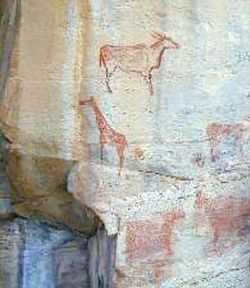Tsodilo
| Tsodilo | |
|---|---|
|
Rock art at Tsodilo | |
| Location | Ngamiland District, Botswana |
| Coordinates | 18°45′0″S 21°44′0″E / 18.75000°S 21.73333°ECoordinates: 18°45′0″S 21°44′0″E / 18.75000°S 21.73333°E |
| Official name: Tsodilo | |
| Type | Cultural |
| Criteria | i, iii, iv |
| Designated | 2001 (25th session) |
| Reference no. | 1021 |
| State Party | Botswana |
| Region | List of World Heritage Sites in Africa |
 Tsodilo Hills | |
The Tsodilo Hills are a UNESCO World Heritage Site (WHS), consisting of rock art, rock shelters, depressions, and caves. It gained its WHS listing in 2001 because of its unique religious and spiritual significance to local peoples, as well as its unique record of human settlement over many millennia. UNESCO estimates that there are over 4500 rock paintings at the site. The site consists of a few main hills known as the Child Hill, the Female Hill, and the Male Hill. These hills are of great cultural and spiritual significance to the San People of the Kalahari.

Geography

There are four chief hills. The highest is 1,400 metres AMSL. This is one of the highest points in Botswana. The four hills are commonly described as the "Male", this is the highest, the "Female", "Child" and an unnamed knoll.
There is a managed campsite between the two largest hills, with showers and toilets. It is near the most famous of the San paintings at the site, the Laurens van der Post panel, after the South-African writer who first described the paintings in his 1958 book 'The Lost World of the Kalahari'. The hills can be reached via a good graded dirt road and are about 40 km from Shakawe. Also by the campsite is a small museum. There is also an airstrip.
Archaeology
People have used the Tsodilo Hills for painting and ritual for thousands of years. UNESCO estimates that the hills contain 500 individual sites representing thousands of years of human habitation. The hills' rock art has been linked to the local hunter gatherers. It is believed that ancestors of the San created some of the paintings at Tsodilo, and were also the ones to inhabit the caves and rock shelters. There is evidence that Bantu peoples were responsible for some of the artworks at the hills.[1] Some of the paintings have been dated to be as early as 24,000 years before present.[2]
Rhino Cave
Rhino Cave is located at the North end of the Female Hill and has two main walls where paintings are located. The white rhino painting which the cave is named for is located on the north wall, and is split by another painting of a red giraffe.[1] Excavations of the cave floor turned up many lithic materials from. While the cave lacks ostrich egg shell, bone artifacts, pottery or iron, there were a few mongongo shell fragments found in Later Stone Age layers.[1]
Charcoal found during excavations has been dated to the African Iron Age, the LSA, and the Middle Stone Age. Artifacts, mostly stone, from the LSA were made from local materials such as quartz and jasper.[1] MSA artifacts from the cave are mostly prepared projectile points. The points are typically found in various stages of production; some have been abandoned and some are finished.[1]
The paintings at Rhino Cave are mostly located on the North wall, and have been painted in red or red-orange pigment excepting the rhino which was painted in white. Around the rhino and the giraffe are various paintings, mostly in red, of geometrics.[1] On the opposite wall, the cave is host to grooves and depressions that have been ground into the rock. They may have been created using hammer stones or grindstones from the LSA period, which have been found at Tsodilo.[1]

White Paintings
The white colored rock art at Tsodilo is associated with Bantu peoples.[1] Many of the white paintings are located in the aptly named White Paintings Rock Shelter, located on the Male Hill.[3] There are also red paintings in this shelter, but they are in abundance around the hills. The white paintings depict animals, both domestic and wild, as well as human like figures.[3] The human figures are painted with their hands on their hips for the most part. A handful of them are on horseback, which seems to indicate that they were painted no sooner than the mid 1800s, when horses were first introduced to the area.[3]

Dates taken from charcoal, ostrich egg shell and bone samples, and the deposits ranged from the LSA to the MSA.[3] There is even some evidence that the site was used in during the historical period in Africa. A nylon button, as well as European glass beads, were found in the top layers of excavations at the site.[3] LSA layers included hammer stones and grindstones, along with bone artifacts and mircolithics. Pottery sherds, ostrich egg shell beads, and mongongo shells were also uncovered.[3] MSA deposits included stone blades as well as other lithic tools.
Red Paintings
The Tsodilo Hills have a myriad of red rock art; it can be found all over the site. In Rhino Cave, some of the red paintings seem to be older than the white rhino. Red paintings here, and around Tsodilo, are attributed to the San.[1]


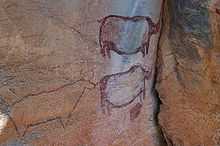
Depression Rock Shelter Site
Located on the northwest side of the Female Hill, this site gets it name from the depressions that have been ground into the shelter walls. Accompanying these marks are red paintings of what appear to be cattle, as well as geometrics.[4] The rock shelter site, dated from charcoal samples, had its earliest occupation at least 30,000 years ago.[4] Excavations dug up LSA stone tools and Iron Age artifacts. Pottery found in the deepest layers was dated to the first century, and is affiliated with the oldest stone artifacts found in this area.[4] Mongongo nut shells were also uncovered in the various deposits, including the deepest layers, which makes them the oldest mongongo nuts ever found in archaeological context.[4]
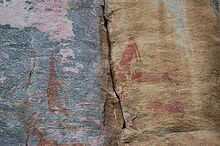
Metallurgy
The Tsodilo Hills are made up of a number archaeological sites. Two of these sites, known as Divuyu and Nqoma, have evidence of Early Iron Age metal artifacts [5] Excavated from the two sites contained fragments of jewelry and metal tools, all made from iron and/or copper. Jewelry pieces were from bangles, beads, chains, earrings, rings, and pendants, while tools included chisels, projectiles and arrow heads, and even blades.[5] These two sites share similar fabrication technology, but have different styles of metal working. Slag and tuyères seem to indicate that Divuyu and Nqoma may have been iron smelting areas, making them one of the few Early Iron Age sites in southern Africa with evidence of metal working.[5]
Cultural significance
These hills are of great cultural and spiritual significance to the San peoples of the Kalahari. They believe the hills are a resting place for the spirits of the deceased and that these spirits will cause misfortune and bad luck if anyone hunts or causes death near the hills. Tsodilo is also one of many places that is argued over in the Kalahari Debate.[6]
Oral Traditions
Many local peoples around the Tsodilo Hills have stories of times past that deal with the many painted caves and rock shelters at the site. Oral traditions often tell of the Zhu people, a local San group, using rock shelters for protection from the elements or as ritual areas.[3]
One tale claims that hunters would come into the rock shelters to contact ancestors if a hunt was unsuccessful. They would then ask for a good hunt the next time they went out.[7] In thanks, when the hunt was successful, the people would return to the shelter and cook for their ancestors. In some of these alleged campsites, there is little to no evidence of fire remains.[7]
Still, there are areas where rituals, such as rain making prayers, are performed. Older people in the area can still remember using some rock shelters as campsites when they were children. The Whites Paintings rock shelter may have been used as a camp during the rainy season as early as 70 – 80 years ago.[3]
The local San people believe Tsodilo is the birthplace of all life, art there made by the descendants of the first people. Tsodilo’s geography, trails and grooves in the earth are known as the trails and footprints of the first animals, making their way to the first watering hole [8]). A natural water spring at Tsodilo, near the Female Hill, is used as both a water collection site and a ritual site. It is seen as sacred, and used by countless peoples to cleanse, heal, and protect.[8]
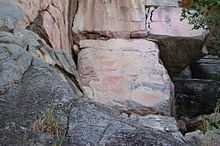

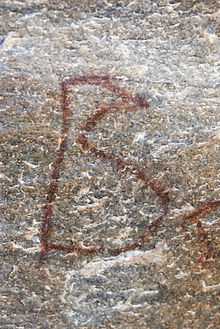
Notes
- ↑ 1.0 1.1 1.2 1.3 1.4 1.5 1.6 1.7 1.8 Robbins, Lawrence; Murphy, Michael; Campbell, Alec; Brook, George (1996). "Excavations at the Tsodilo Hills Rhino Cave". Botswana Notes and Records 28.
- ↑ C.Michael Hogan. 2008
- ↑ 3.0 3.1 3.2 3.3 3.4 3.5 3.6 3.7 Robbins, L.H.; Murphy, M.L.; Brook, G.A.; Ivester, A.H.; Campbell, A.C; Klein, R.G.; Milo, R.G.; Stewart, K.M.; Downey, W.S.; Stevens, N.J. (2000). "Archaeology, Palaeoenvironment, and Chronology of the Tsodilo Hills White Paintings Rock Shelter, Northwest Kalahari Deser, Botswana". Journal of Archaeology Science 27 (11): 1085–1113. doi:10.1006/jasc.2000.0597.
- ↑ 4.0 4.1 4.2 4.3 Robbins, L.H.; Campbell, A.C. (1989). "The Depression Rock Shelter Site, Tsodilo Hills". Botswana Notes and Records: 1–3.
- ↑ 5.0 5.1 5.2 Miller, Duncan; van der Merwe, Nikolaas (1994). "Early Iron Age Metal Working at the Tsodilo Hills, Northwestern Botswana". Journal of Archaeological Science 21: 101–115. doi:10.1006/jasc.1994.1011.
- ↑ Sadr, Karim (1997). "Kalahari archaeology and the Bushman debate". Current Anthropology: 104–112.
- ↑ 7.0 7.1 Campbell, A.C.; Robbins, L.H.; Murphy, M.L. (1994). "Oral Traditions and Archaeology of the Tsodilo Hills Male Hill Cave". Botswana Notes and Records: 37–54.
- ↑ 8.0 8.1 Segadika, Phillip (2006). "Managing Intangible Heritage at Tsodilo". Museum International (58): 31.
References
- Ursula Erasmus (1992) Bushman Culture, published by Excalibur, 315 pp ISBN 1-85634-191-7
- C. Michael Hogan (2008) Makgadikgadi, The Megalithic Portal, ed. A. Burnham
- Luis Pancorbo (2000) "Al fin las colinas de Tsodilo" en "Tiempo de África". pp. 280–286. Laertes, Barcelona. ISBN 84-7584-438-3
- Sheila Coulson, Sigrid Staurset, and Nick Walker (2011) "Ritualized Behavior in the Middle Stone Age: Evidence from Rhino Cave, Tsodilo Hills, Botswana" PaleoAnthropology 2011:18-61
